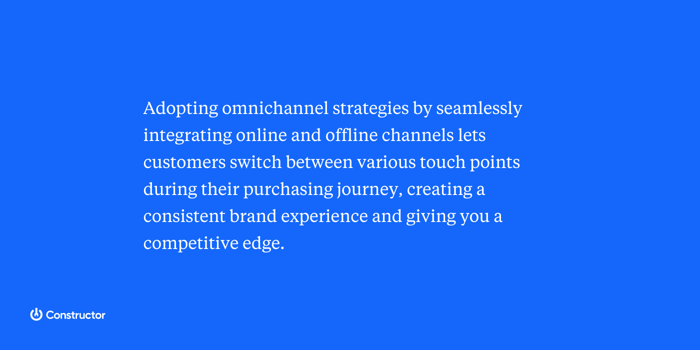
Enhanced consumer experience, improved data insights, increased revenue and operational organization –– the reasons to stay on top of the latest ecommerce digital transformation trends are numerous. But the benefits of harnessing digital solutions are universal, making life as a merchandiser that much easier.
Let’s explore how some of the top digital transformation trends can help ecommerce brands break through to a wider profit margin, customer satisfaction, and overall business growth.
Headless, API-Driven Ecommerce Drives Continued Adaptability
Ecommerce business owners know that adaptability and speed is key to success in today’s market. Even in an upturn economy, customer expectations can change in the fifteen seconds it takes to watch a TikTok video or Instagram reel.
That’s why the next-generation ecommerce tech stack is modular. Think: composable, customizable, and very flexible.
Headless technology refers to the decoupling of the front-end presentation layer (the “head”) from the back-end functionality and data management (the “body”). The software communicates with each other via APIs.
Headless architecture permits flexibility and customization that traditional do-it-all monoliths normally put a hamper on, like allowing B2C and B2B businesses to adopt latest front-end technologies more easily without affecting the underlying systems.
API-first and headless technologies not only help businesses stay relevant and experiment, but they also allow for consistent customer experience across channels.

Brands Embrace Transformer-Powered Product Discovery Platforms
The evolution of enterprise product discovery has expanded rapidly over the past few years, and ChatGPT has pushed product search and discovery in an exciting direction.
Consumers are used to searching odd phrases like “green paint bathroom” or “best hazelnut coffee pods keurig” in an attempt to hack traditional search engine algorithms. Luckily, cutting-edge solutions powered by clickstream data to personalize product discovery experiences are also leaning into transformers (the “T” in ChatGPT) and large language models (LLMs). The trio work together to truly understand natural language queries and filter down irrelevant results to return more attractive items.
But when it comes to evaluating the effectiveness of transformer-powered discovery tools in enterprise ecommerce, there are challenges (and expenses) associated with their training. That’s why experimentation is a prerequisite for ROI in the ChatGPT era.
While most companies are still either just scratching the surface or over promising inflated results from the use of transformers, working with a transparent product discovery partner that is innovating on these technologies will be a major competitive advantage.
Brands Continue Pushing Seamless Customer Experiences
With 69% of customers claiming they’ll continue to shop with a brand after having a positive site, delivery, and return experience, using data analytics and AI technologies to tailor the shopping experience and personalize recommendations will continue to be a key digital transformation trend in ecommerce.
Customers will expect brands to meet their expectations and make it easy for them to find what they need, when they need it. One way to do this is via offering various fulfillment options — like buy online, pick up in-store (BOPIS) — and allowing returns across multiple channels, like store drop-off or lockers.
Adopting omnichannel strategies by seamlessly integrating online and offline channels enables customers to switch between various touch points during their purchasing journey, creating a consistent brand experience and helping you stand out.

Innovative Tech Allows for Greater Focus on Profitability
As consumers continue to exhibit unpredictable spending habits, retailers may benefit from thinking beyond customer purchases as their sole source of profit and exploring additional methods of converting website traffic into revenue.
Take retail-giant Walmart for example. Walmart has recognized their profit streams are shifting from in-store generated revenue to other faster-growing parts of their business, such as website advertising fees and a third-party marketplace on Walmart.com. Over the next five years, Walmart expects these new digital revenue streams to outpace sales from in-store merchandise.
Investing in ecommerce digital transformation trends –– and in Walmart’s case, convenience for consumers –– doesn’t have to be super complex, or even involve a five-to-ten year plan (though you should consider longevity as much as possible). The right digital solutions can also improve long-term operational efficiency to help reduce business costs and waste, effectively increasing profitability.
Online Merchants Use Tech to Free Up Hours
You’d be hard-pressed to find a merchandising team that would turn down gaining back some extra hours in their day. Thanks to AI-powered solutions, spinning time back into the hands of ecommerce teams isn’t just fodder for a Black Mirror episode.
The artful science of searchandising is a great example.
More than half of merchandising employees report that their teams spend more than 20 hours a week on manual merchandising tasks. Sorting through big data, insights, and other customer actions requires technology if business goals are to be met simultaneously.
The best AI-assisted merchant tools can streamline these workstreams so merchandising teams can focus on strategic work.
Ecommerce Digital Transformation Trends Takeaways
Digital transformation trends can help create a more connected, efficient, and customer-centric organization that can thrive in the digital age.
But for deep-rooted change, the focus of ecommerce digital transformation shouldn’t be solely on adopting new and exciting technology –– cultural and organizational changes should be kept in mind as well. It requires a shift in mindset, embracing a digital-first approach, fostering a culture of innovation, and developing digital skills within the workforce.
No pressure, right?
It may feel like a lot to take on, especially if your current business processes and technology stacks are less than up-to-date. But think of ecommerce digital transformation as a journey.
Investing in the right technology and future-proof strategies is akin to forming a new partnership that will revolutionize your business, all while taking a great deal off your crowded plate.